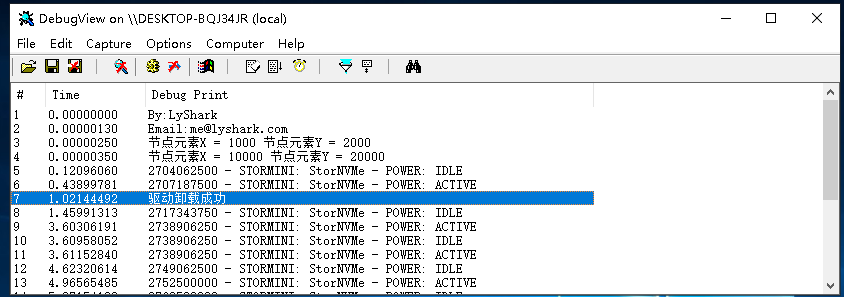驅動開發:核心中的自旋鎖結構
2022-09-28 12:01:05
提到自旋鎖那就必須要說連結串列,在上一篇《驅動開發:核心中的連結串列與結構體》文章中簡單實用連結串列結構來儲存程序資訊列表,相信讀者應該已經理解了核心連結串列的基本使用,本篇文章將講解自旋鎖的簡單應用,自旋鎖是為了解決核心連結串列讀寫時存線上程同步問題,解決多執行緒同步問題必須要用鎖,通常使用自旋鎖,自旋鎖是核心中提供的一種高IRQL鎖,用同步以及獨佔的方式存取某個資源。
首先以簡單的連結串列為案例,連結串列主要分為單向連結串列與雙向連結串列,單向連結串列的連結串列節點中只有一個連結串列指標,其指向後一個連結串列元素,而雙向連結串列節點中有兩個連結串列節點指標,其中Blink指向前一個連結串列節點Flink指向後一個節點,以雙向連結串列為例。
#include <ntifs.h>
#include <ntstrsafe.h>
/*
// 連結串列節點指標
typedef struct _LIST_ENTRY
{
struct _LIST_ENTRY *Flink; // 當前節點的後一個節點
struct _LIST_ENTRY *Blink; // 當前節點的前一個結點
}LIST_ENTRY, *PLIST_ENTRY;
*/
typedef struct _MyStruct
{
ULONG x;
ULONG y;
LIST_ENTRY lpListEntry;
}MyStruct,*pMyStruct;
VOID UnDriver(PDRIVER_OBJECT driver)
{
DbgPrint("驅動解除安裝成功 \n");
}
// By: LyShark
NTSTATUS DriverEntry(IN PDRIVER_OBJECT Driver, PUNICODE_STRING RegistryPath)
{
DbgPrint("By:LyShark \n");
DbgPrint("Email:[email protected] \n");
// 初始化頭節點
LIST_ENTRY ListHeader = { 0 };
InitializeListHead(&ListHeader);
// 定義連結串列元素
MyStruct testA = { 0 };
MyStruct testB = { 0 };
MyStruct testC = { 0 };
testA.x = 100;
testA.y = 200;
testB.x = 1000;
testB.y = 2000;
testC.x = 10000;
testC.y = 20000;
// 分別插入節點到頭部和尾部
InsertHeadList(&ListHeader, &testA.lpListEntry);
InsertTailList(&ListHeader, &testB.lpListEntry);
InsertTailList(&ListHeader, &testC.lpListEntry);
// 節點不為空 則 移除一個節點
if (IsListEmpty(&ListHeader) == FALSE)
{
RemoveEntryList(&testA.lpListEntry);
}
// 輸出連結串列資料
PLIST_ENTRY pListEntry = NULL;
pListEntry = ListHeader.Flink;
while (pListEntry != &ListHeader)
{
// 計算出成員距離結構體頂部記憶體距離
pMyStruct ptr = CONTAINING_RECORD(pListEntry, MyStruct, lpListEntry);
DbgPrint("節點元素X = %d 節點元素Y = %d \n", ptr->x, ptr->y);
// 得到下一個元素地址
pListEntry = pListEntry->Flink;
}
Driver->DriverUnload = UnDriver;
return STATUS_SUCCESS;
}
連結串列輸出效果如下:

如上所述,核心連結串列讀寫時存線上程同步問題,解決多執行緒同步問題必須要用鎖,通常使用自旋鎖,自旋鎖是核心中提供的一種高IRQL鎖,用同步以及獨佔的方式存取某個資源。
#include <ntifs.h>
#include <ntstrsafe.h>
/*
// 連結串列節點指標
typedef struct _LIST_ENTRY
{
struct _LIST_ENTRY *Flink; // 當前節點的後一個節點
struct _LIST_ENTRY *Blink; // 當前節點的前一個結點
}LIST_ENTRY, *PLIST_ENTRY;
*/
typedef struct _MyStruct
{
ULONG x;
ULONG y;
LIST_ENTRY lpListEntry;
}MyStruct, *pMyStruct;
// 定義全域性連結串列和全域性鎖
LIST_ENTRY my_list_header;
KSPIN_LOCK my_list_lock;
// 初始化
void Init()
{
InitializeListHead(&my_list_header);
KeInitializeSpinLock(&my_list_lock);
}
// 函數內使用鎖
void function_ins()
{
KIRQL Irql;
// 加鎖
KeAcquireSpinLock(&my_list_lock, &Irql);
DbgPrint("鎖內部執行 \n");
// 釋放鎖
KeReleaseSpinLock(&my_list_lock, Irql);
}
VOID UnDriver(PDRIVER_OBJECT driver)
{
DbgPrint("驅動解除安裝成功 \n");
}
// By: LyShark
NTSTATUS DriverEntry(IN PDRIVER_OBJECT Driver, PUNICODE_STRING RegistryPath)
{
DbgPrint("By:LyShark \n");
DbgPrint("Email:[email protected] \n");
// 初始化連結串列
Init();
// 分配連結串列空間
pMyStruct testA = (pMyStruct)ExAllocatePool(NonPagedPoolExecute, sizeof(pMyStruct));
pMyStruct testB = (pMyStruct)ExAllocatePool(NonPagedPoolExecute, sizeof(pMyStruct));
// 賦值
testA->x = 100;
testA->y = 200;
testB->x = 1000;
testB->y = 2000;
// 向全域性連結串列中插入資料
if (NULL != testA && NULL != testB)
{
ExInterlockedInsertHeadList(&my_list_header, (PLIST_ENTRY)&testA->lpListEntry, &my_list_lock);
ExInterlockedInsertTailList(&my_list_header, (PLIST_ENTRY)&testB->lpListEntry, &my_list_lock);
}
function_ins();
// 移除節點A並放入到remove_entry中
PLIST_ENTRY remove_entry = ExInterlockedRemoveHeadList(&testA->lpListEntry, &my_list_lock);
// 輸出連結串列資料
while (remove_entry != &my_list_header)
{
// 計算出成員距離結構體頂部記憶體距離
pMyStruct ptr = CONTAINING_RECORD(remove_entry, MyStruct, lpListEntry);
DbgPrint("節點元素X = %d 節點元素Y = %d \n", ptr->x, ptr->y);
// 得到下一個元素地址
remove_entry = remove_entry->Flink;
}
Driver->DriverUnload = UnDriver;
return STATUS_SUCCESS;
}
加鎖後執行效果如下:

文章作者:lyshark (王瑞)
文章出處:https://www.cnblogs.com/LyShark/p/16737096.html
版權宣告:本部落格文章與程式碼均為學習時整理的筆記,文章 [均為原創] 作品,轉載請 [新增出處] ,您新增出處是我創作的動力!
轉載文章,請遵守《中華人民共和國著作權法》相關規定或遵守《署名CC BY-ND 4.0國際》禁止演繹規範,合理合規,攜帶原創出處轉載。
文章出處:https://www.cnblogs.com/LyShark/p/16737096.html
版權宣告:本部落格文章與程式碼均為學習時整理的筆記,文章 [均為原創] 作品,轉載請 [新增出處] ,您新增出處是我創作的動力!
轉載文章,請遵守《中華人民共和國著作權法》相關規定或遵守《署名CC BY-ND 4.0國際》禁止演繹規範,合理合規,攜帶原創出處轉載。